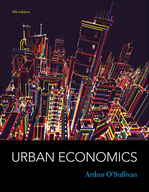Solution Found!
Innovation and Market Areas Consider the example shown in Figure 2–1 . Depict graphically the effects of the following sequence of changes on the “martini glass” fi gure and the width of a factory’s market area. The changes are cumulative. a. An innovation in production that doubles labor productivity in factories will [shorten, lengthen, not change] the stem of the martini glass from _____ loaves to _____ loaves because. . . . b. The width of the market area increases from 16 miles (8 miles on each side) to _____ miles ( _____ on each side) because. . . . c. An innovation in transportation that doubles consumer travel speeds will [decrease, increase, not change] the slope of the martini glass from _____ loaf per mile to _____ loaf per mile. d. The width of the market area increases from _____ miles ( _____ on each side) to _____ ( _____ on each side) miles because. . . .
Chapter 2, Problem 5(choose chapter or problem)
Innovation and Market Areas
Consider the example shown in Figure 2–1. Depict graphically the effects of the following sequence of changes on the “martini glass” figure and the width of a factory’s market area. The changes are cumulative.
a. An innovation in production that doubles labor productivity in factories will [shorten, lengthen, not change] the stem of the martini glass from _____ loaves to _____ loaves because. . . .
b. The width of the market area increases from 16 miles (8 miles on each side) to _____ miles ( _____ on each side) because. . . .
c. An innovation in transportation that doubles consumer travel speeds will [decrease, increase, not change] the slope of the martini glass from _____ loaf per mile to _____ loaf per mile.
d. The width of the market area increases from _____ miles ( _____ on each side) to _____ ( _____ on each side) miles because. . . .
Questions & Answers
QUESTION:
Innovation and Market Areas
Consider the example shown in Figure 2–1. Depict graphically the effects of the following sequence of changes on the “martini glass” figure and the width of a factory’s market area. The changes are cumulative.
a. An innovation in production that doubles labor productivity in factories will [shorten, lengthen, not change] the stem of the martini glass from _____ loaves to _____ loaves because. . . .
b. The width of the market area increases from 16 miles (8 miles on each side) to _____ miles ( _____ on each side) because. . . .
c. An innovation in transportation that doubles consumer travel speeds will [decrease, increase, not change] the slope of the martini glass from _____ loaf per mile to _____ loaf per mile.
d. The width of the market area increases from _____ miles ( _____ on each side) to _____ ( _____ on each side) miles because. . . .
ANSWER:Step 1 of 5
The result of the industrial revolution was the development of factory cities. Cities started specializing in producing one good, like Manchester, a hub of textile mills that clothed around one-third of the world during the 1850s.
